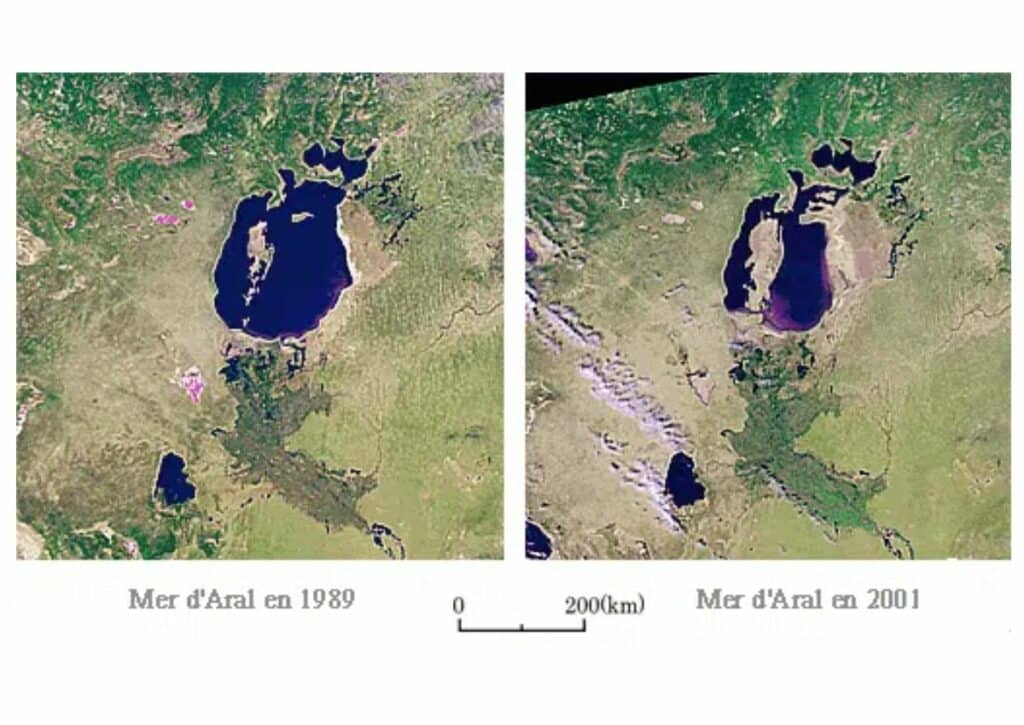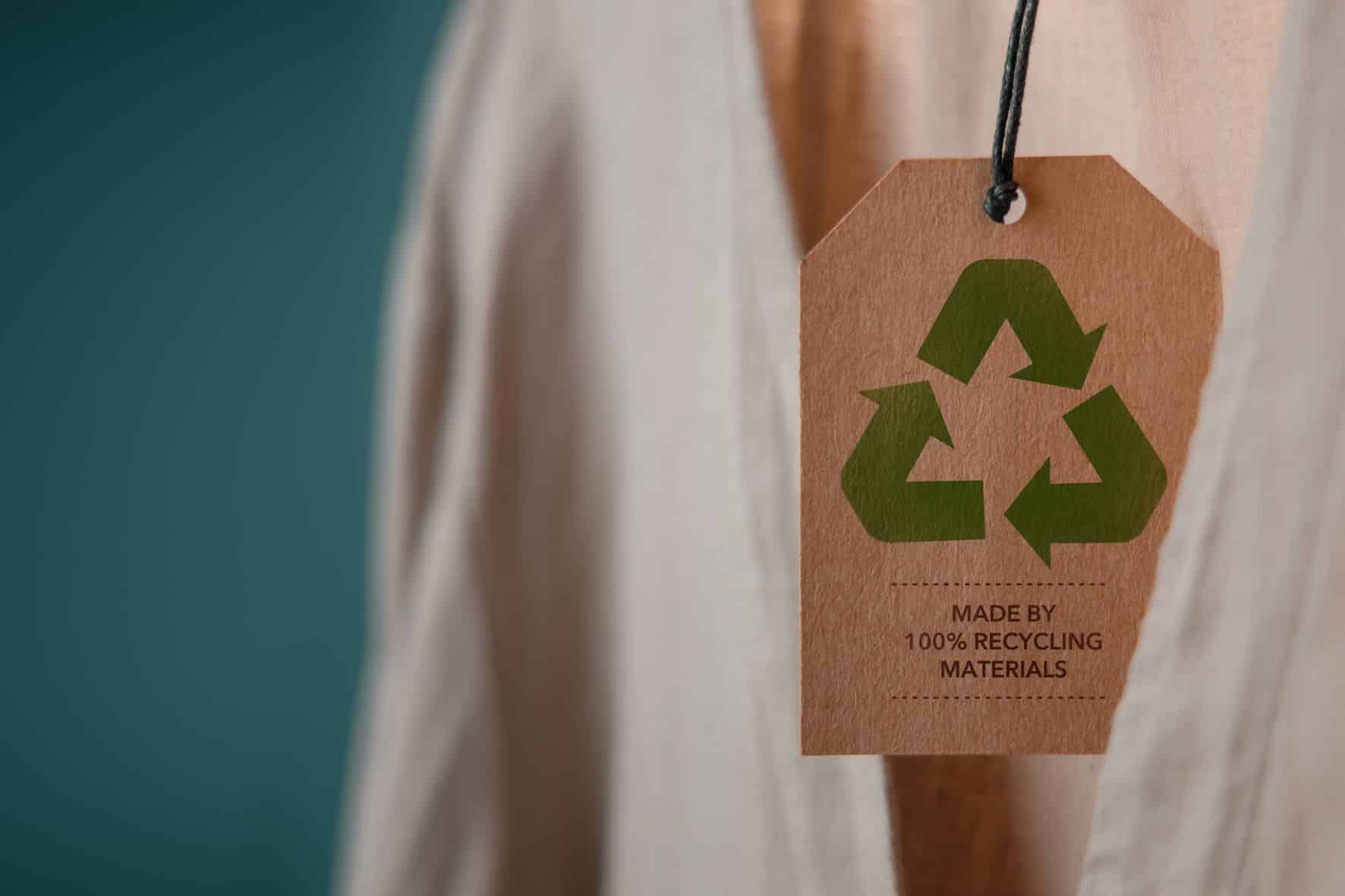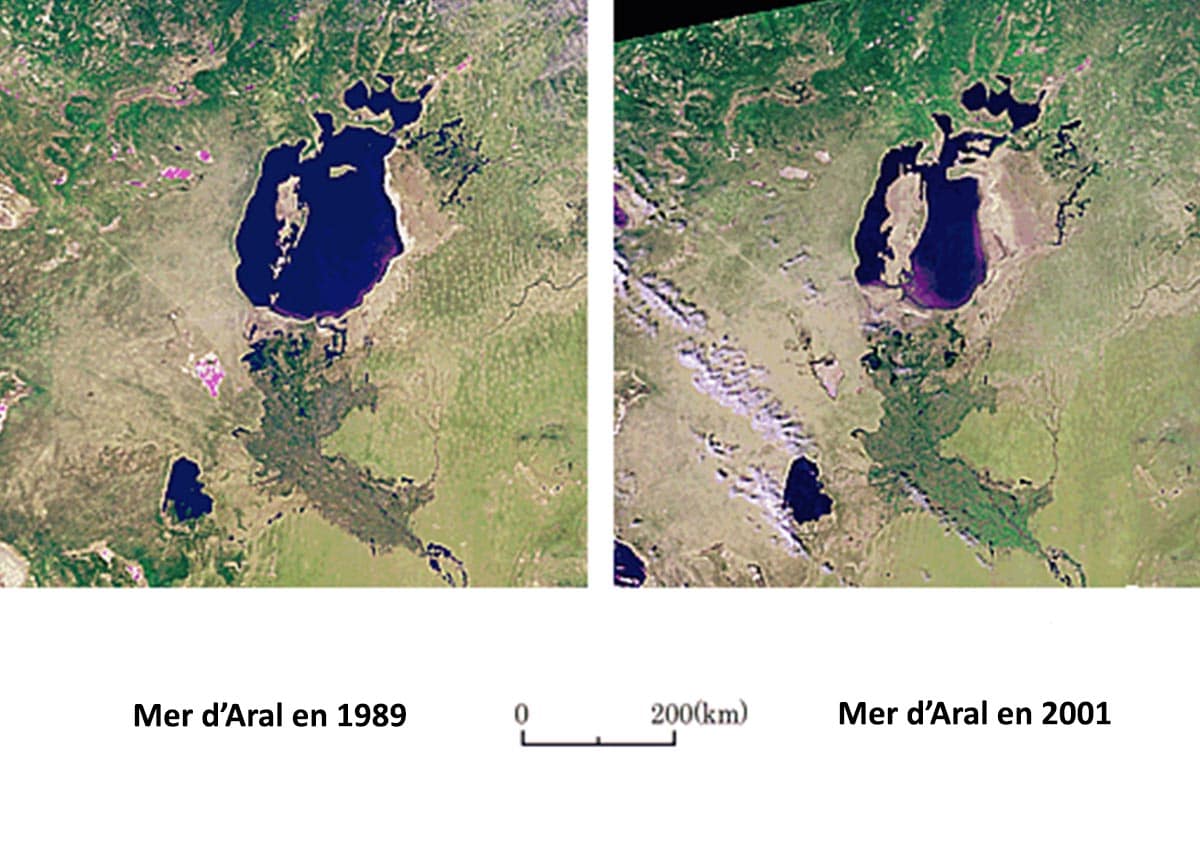Le coton constitue une mine d’or pour bien des pays Asiatiques. Dans les années 50, il était même considéré comme l’Or Blanc de l’URSS. Mais sa culture n’est pas sans conséquence sur l’environnement…. En témoigne La Mer d’Aral, catastrophe écologique. Pouvons-nous enfin parler de prise de conscience écologique ?
Le coton en culture intensive bouleverse l’équilibre écologique
Sous l’ère Stalinienne, la culture intensive du coton bouleverse une région complète du Monde et engendre une catastrophe écologique qui en fait les frais encore aujourd’hui : la Mer d’Aral passe de 67 000km² en 1960 à 21 000km² en 2010.
A en croire les dernières photos satellites, la mer d’Aral n’est pas très en forme. En tout cas, toujours loin de sa forme initiale. Partagée entre le Kazakhstan et l’Ouzbékistan, elle était la 4ième plus grande mer intérieure au monde. Deux fleuves assuraient sa pérennité : l’Amou Daria au Sud, et le Sir Daria au Nord.
Initialement grande comme deux fois et demie la Bretagne, elle a perdu les 2/3 de sa superficie et les 3/4 de son volume !
De plus, à partir de 1987, la mer s’est progressivement divisée en deux parties ; une grande au sud appelée la grande mer, et une plus petite au nord appelée la petite mer. Aralsk qui était le port principal au nord, est aujourd’hui à plus de 80 km des côtes. Muniak, celui du Sud, à plus de 120 km. Ces deux ports sont aujourd’hui orphelins : celle qui a permis leur développement économique et social est partie, abandonnant contre son gré les pêcheurs qui faisaient autrefois sa fierté.

Pourquoi une telle catastrophe écologique ?
Au milieu du siècle dernier, les planificateurs soviétiques attribuent à l’Asie centrale le premier rôle dans la production du coton (premier fournisseur de cette matière première). Les régions concernées seront les steppes du Kazakhstan et de l’Ouzbékistan, des terres semi arides. Or, pour cultiver du coton, il faut de la chaleur, mais aussi de l’eau…beaucoup d’eau. Cette eau, on la trouve grâce aux deux fleuves qui alimentent la mer d’Aral : Le Sir Daria au nord au nord (Kazakhstan), l’Amou Daria au sud (Ouzbékistan). Mais compte tenu du climat, l’irrigation s’impose. La mer d’Aral et ses affluents semblent une source inépuisable. Des centaines de canaux d’irrigation sont alors construites, accompagnés d’un usage massif d’engrais et de pesticides pour développer et intensifier cette culture très rentable : De 1960 à 1990, la zone irriguée en Asie centrale passe de 3,5 à 7,5 millions d’hectares et la région devient le quatrième producteur mondial de coton.
Pour cette même période, le volume d’eau prélevé dans les fleuves va simplement doubler ; mais au final, la mer d’Aral recevra 10 fois moins d’eau douce que dans les années 50. La rupture de ” l’équilibre hydrique établi” se manifeste sans attendre par deux phénomènes majeurs : une salinité des eaux multipliée par trois et une baisse du niveau de la mer d’environ 15 m. Début des années 90, c’est la consternation :
- La hausse de la salinité a décimé la presque totalité des 30 espèces de poissons (seules 2 survivront dont le Cambala, importé de la mer d’Azov en 1979).
- La baisse du niveau de la mer entamé dès 1960, a provoqué l’éloignement des côtes à plusieurs dizaines de km.
La communauté internationale se penche alors vers ce qui sera appelée l’une des plus grandes catastrophes écologiques de ce siècle. Mais au delà de ces conséquences sur l’environnement, c’est un chamboulement économique et social pour près de 5 millions de personnes dont l’Aral rythmait le quotidien.
La mer d’Aral : catastrophe humaine, écologique et économique
Avec le recul de la mer, c’est un vaste fond marin à ciel ouvert chargé de sel et de poussières toxiques que soulève le vent. Les nappes phréatiques se sont peu à peu asséchées et les quelques sources encore disponibles sont devenues trop salées et polluées… Les maladies rénales ont alors explosé. De même : anémies, cancers, affections hépatiques et maladies infantiles sont des pathologies en constante augmentation dans la région. La tuberculose a atteint des proportions épidémiques : il y avait, dans certaines villes, 400 cas pour 100 000 habitants selon un rapport de l’UNESCO en 2000.
A Aralsk, le centre anti-peste a repris son activité pour déceler quelques cas isolés. Les rongeurs des steppes ont gagné du terrain au profit du retrait de la mer ; leurs puces portent des germes qu’elles transmettent aux animaux et au bétail… puis à l’homme. « Rien d’alarmant, seulement inquiétant… Il faut être sur le qui-vive, et bien analyser l’évolution de ces rongeurs… » souligne Maltay Nétalin, Directeur du centre anti-peste d’Aralsk.
Et puis, les nouvelles conditions climatiques n’arrangent rien : avec le départ de l’Aral, elles ont beaucoup changé. Les embruns rafraîchissants de la mer ont laissé place aux balais incessant(s) du sable et du vent. Les précipitations se font rares et la chaleur de l’été est devenue insupportable. Les défenses immunitaires de la population se sont affaiblies considérablement.
De leur prospère passé, Aralsk et Muniak n’ont gardé que ruines et décombres laissant de vieilles carcasses rouillées habiller le port sans mer d’un nouveau décor. L’économie de la pêche et de la construction navale est anéantie. Dans l’indifférence presque totale, hommes et femmes ont été ruinés, trompés par les politiques qui promettent depuis 40 ans le retour de leur mer. Les plus riches sont partis, les autres tentent une reconversion ; mais c’est bien souvent dans l’alcoolisme qu’ils se réfugient Dans ces deux villes, le taux de chômage est estimé aux environs de 60%… A Aralsk, la population a dégringolée… de 65 000 à 32 000 habitants.
… Une lueur d’espoir pour les hommes
Aujourd’hui, le grand dérèglement écologique et économique de cette région est unanime. Cependant, il faut ajouter un bémol au catastrophisme que les médias aiment annoncer : Si la partie sud, appelée « la grande mer », est vouée à un assèchement définitif selon la communauté scientifique, la partie nord, « la petite mer », connaît en revanche un léger sursis. La raison en est simple : à la différence du sud où le fleuve Amou Daria est toujours détourné pour la culture du coton, le Sir Daria au nord, déverse désormais dans l’Aral un débit conséquent et régulier. Depuis trois ans, le niveau de la petite mer se stabilise et la salinité n’augmente plus. (rappelons que la forte montée de la salinité en 20 ans a décimé la presque totalité des 30 espèces de poissons vivant dans l’Aral).
Avec cette inauguration, c’est toute une région qui espère : Le retour de la mer signifie une éventuelle amélioration des conditions climatiques et écologiques, mais pas seulement ; également l’assurance d’une activité de pêche pérenne. Car Si tous les projecteurs médiatiques sont tournés vers la construction du barrage, il ne faut pas oublier le travail de fond et de patience mené par la corporation de pêcheurs…
Qui aurait pu croire que la mer d’Aral redonnerait un jour du travail aux pêcheurs ?
C’est pourtant chose faite ! Depuis quelques années, de novembre à mars, les rives de la petite mer d’Aral revêtent un décor invraisemblable : des camps de pêcheurs s’installent et c’est un vaste camping qui s’organise. La mer d’Aral s’est retirée à plusieurs dizaines de kilomètres des côtes, ce sont donc les pêcheurs qui la rejoignent. Ils prennent congé de leur famille pour quelques mois, le temps d’accomplir une campagne de pêche encore impensable il y a 10 ans…. Cabanes en taules, yourtes en terre, remorques de camion…voici les principales composantes de ce décor saisonnier. On se déplaçait jadis à dos de chameau, on chevauche aujourd’hui sa moto ou son side-car.
Y aurait-il alors à nouveau du poisson en mer d’Aral ?
« En fait, ça n’a jamais été le problème, confie un responsable de pêche. En voyant le recul de la mer et surtout la salinité augmenter, les russes ont introduit une espèce de substitution à la fin des années 70, le Cambala… ». Ce poisson plat qui s‘apparente à la limande, possède une formidable capacité d’adaptation. Pendant 30 ans il s’est reproduit considérablement sans être pêché ! Les kazakhs ne possédaient pas les bons filets et se méfiaient de cette espèce inconnue. Alors, pour permettre à l’activité de pêche de redémarrer, il a fallu redonner force et confiance à tous ces pêcheurs désabusés et … ruinés. A ce stade, l’aide ne pouvait venir que de l’extérieur ; l’économie locale étant désorganisée et le gouvernement kazakh désemparé : Avec son indépendance déclarée en 1991, le Kazakhstan doit faire face à « d’autres priorités… ». Le Danemark fut ce mécène. En collaboration avec les pêcheurs locaux, des pêcheurs danois ont mis en place une aide permettant de fournir du matériel adéquat (filets adaptés pour la pêche du Cambala, moteurs Hors-bord, vêtements …), une formation aux nouvelles techniques de pêche et,… de l’essence. Ainsi les pêcheurs ont pu développer de nouvelles campagnes de pêche et organiser leurs déplacements jusqu’à la mer puis l’acheminement du poisson jusqu’aux lieux de vente.
Aujourd’hui, l’eau douce apportée par le Sir Daria contribue à la régénérescence du milieu aquatique. Outre le Cambala, ce sont de nouvelles espèces qu’on pensait disparues qui se font à nouveau prendre dans les mailles du filet : carpes, sandres, brochets.
L’organisation de pêcheurs peut se permettre de nouveaux espoirs : Son action cohérente menée depuis quelques années semble récompensée ; un ultime maillon vient terminer la chaîne : La construction d’une usine de poisson à Aralsk ! Les travaux ont débuté en 2004 ; leur fin est prévue pour septembre 2006, mais déjà l’usine a accompli sa première mission…l’hiver dernier. Le poisson récupéré sur la zone de pêche est nettoyé et congelé pour être ensuite exporté dans différents lieux et suivre les processus de transformation aptes à sa commercialisation. Des débouchés économiques se profilent.
La boucle est bouclée et l’horizon se dégage enfin pour tous ces hommes et femmes qui ont su prendre en main leur destin.
L’espoir d’une prise de conscience écologique
Sauver la mer d’Aral est aujourd’hui impossible. On peut néanmoins se réjouir de voir s’accomplir le sauvetage partiel de la partie nord.
L’Homme a-t-il voulu se racheter de ses erreurs commises ?
L’affaire est complexe : Pouvait-on agir plus tôt ? De quelle façon ? Sommes-nous vers une prise de conscience écologique ?
Des projets pour sauver l’Aral, il y en eu… de quoi écrire tout un roman fiction ! Mettre tout le monde d’accord fut un tout autre problème. Il était question de gros sous, comme toujours, mais aussi de politique. Les fleuves Amou Daria et Sir Daria sont partagés par les cinq républiques d’Asie Centrale créees par Staline dans les années 30 : Kazakhstan, Ouzbékistan, Turkménistan, Kirghizstan et Tadjikistan. Et les besoins en eau de chacun sont inégalement répartis, de même que les orientations économiques… Des facteurs qui ont compromis le rétablissement des débits normaux des fleuves. L’Aral ne s’est pas faite attendre pour amorcer son déclin.
Préserver la Petite Mer pour se donner bonne conscience, abandonner la Grande Mer pour assurer l’économie du coton : Telle pourrait être l’analyse portée aujourd’hui à cette situation. Il est de toute évidence trop tard… la machine industrielle est lancée. Le coton représente aujourd’hui 40% des textiles et fait vivre des milliers d’ouzbeks en amont de l’Amou Daria… qu’ importe alors le sort réservé aux habitants démunis en aval du fleuve ? Ces derniers ont tout perdu. Le travail qu’offre la culture du coton n’assèchera jamais leurs larmes. Ils n’ont pas les moyens de partir ni d’organiser leur reconversion ou de troquer leur bateau contre une parcelle de champ de coton. Ils apaisent leur colère par l’annonce d’importantes ressources en gaz découvertes depuis quelques temps dans le bassin de l’Aral. Le climat serait-il soudain devenu salutaire ? On peut toujours endormir les gens avec l’espoir de l’argent et leur faire oublier tout d’un coup qu’ils habitent une des région les plus néfastes du globe. Comment prétendre qu’il y aura du travail et de l’argent pour tout le monde ? l’économie et les intérêts nationaux risquent encore une fois de l’emporter. Aucun intérêt à renflouer l’Aral, donc . A moins que l’argent du coton et du gaz serve à financer les secteurs aussi divers que celui de la santé, de l’enseignement, du logement… et améliore le bien-être social.
Il y a plus de 50 ans, coulait sans crainte dans le même lit, l’eau du Coton et l’eau du poisson. Cette harmonie aujourd’hui détruite doit faire prendre conscience des façons dont on doit mener le développement. La catastrophe écologique de l’Aral est l’exemple extraordinaire d’une nature forcée, déséquilibrée, au profit d’une manœuvre agricole et économique non mesurée.
La culture intensive du coton a cassé l’ordre établi : les populations jouxtant les deux fleuves en amont de l’Aral ont abandonné leur vie tranquille de pêcheur et de maraîcher pour se lancer dans une affaire plus prometteuse instaurée et encouragée par les politiques. Mais pomper l’eau à outrance sans savoir si son voisin en aval va en subir des conséquences, voilà une attitude irréfléchie, indigne, et contre toute morale.
L’exemple de l’Aral doit nous convaincre qu’il n’y a pas à choisir entre économie et environnement ; nous avons à présent le recul nécessaire pour admettre qu’il faut organiser notre société en prenant en compte dans tous ses aspects la nature, profiter de cet éveil à une conscience écologique générale. L’UNESCO a d’ailleurs publié un article sur l’influence des humains et l’exemple de la mer d’Aral
Cette règle est donc simple ; à l’heure où la mode du « Bio » a le vent en poupe et où le développement durable semble poser les bonnes questions sur notre façon de faire évoluer nos économies, répétons-la cette règle, répétons le ce sort de l’Aral, répétons tout cela aux politiques, aux industriels, aux consommateurs : “ Le chemin emprunté est-il toujours le bon ?’’
Dans le cadre de la mer d’Aral, la solution n’était-elle pas d’organiser la transition de méthodes de culture de coton dite conventionnelles vers une méthode de culture bio ? Cette culuture du coton biologique si chère aux Mouettes Vertes et dont on vous parlait dans l’article Du coton bio, naturellement !








